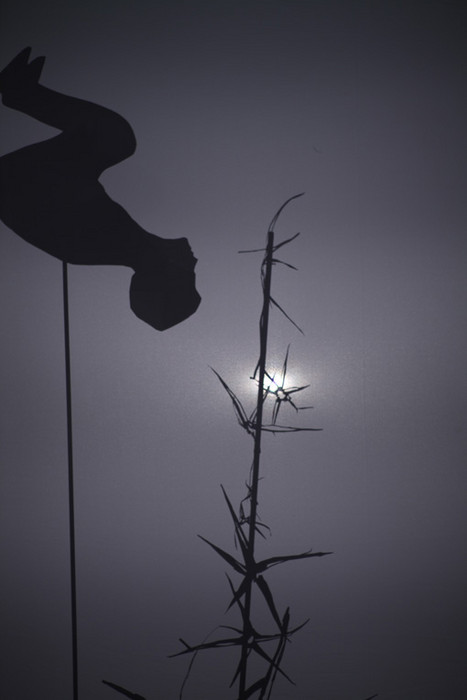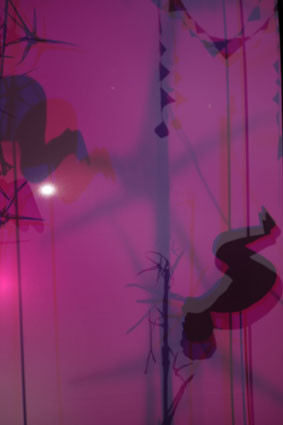Kirstine Roepstorff - Illuminating Shadows
07 Feb - 04 Apr 2010

Kirstine Roepstorff, Detail of Illuminating Shadows, 2010, Courtesy Peres Projects Berlin, Photo: Kim Høgh Mikkelsen

Kirstine Roepstorff, Detail of Illuminating Shadows, 2010, Courtesy Peres Projects Berlin, Photo: Kim Høgh Mikkelsen
The first major individual exhibition in Austria by Danish artist Kirstine Roepstorff extends to two institutions, showing a series of works developed especially for this context: Galerie im Taxispalais, Innsbruck and Stadtgalerie Schwaz.
Kirstine Roepstorff belongs to a young generation of artists who are working in a novel way with the technique of collage. Using this medium she has developed an unusual visual language, which she transposes into space-consuming installations, objects and sculptures in order to investigate cultural contexts and trigger new narratives. In a manner that is simultaneously glamorous and playful, but also politically demanding, she employs collage as a tool with which to develop a system of reflection and reference. The collage technique makes it possible to tie everything together and even to include aspects that are not present; the negative, the empty space of what has been cut out always refers to things absent as well. The materials she uses are not by any means luxurious, but visually, symbolically and psychologically charged: felt, leather, fabric, tinsel, glass jewellery and paper. She borrows her motifs from historical and contemporary pictorial language, illustrations from politics and advertising, and the artefacts of various cultures. Her collages can be read as visual essays that investigate “the primary forms of our culture and our cultural heritage as they are manifest in energies, materials or everyday functional objects” (K. Roepstorff). Applying poetic, post-feminist aesthetics and an ornamental narrative form, she tackles explosive themes focusing on questions like identity construction, society’s problem zones, cultural differences and our perception of them.
Kirstine Roepstorff has chosen shadows as the theme of her double exhibition Illuminating Shadows in Galerie im Taxispalais and Stadtgalerie Schwaz, giving the topic differing emphases in each of the venues. Her works play with the concepts of shadows, projections and fading memories. The shadow investigates things that are absent; it is the absence of light that causes a shadow to arise in the first place. In this way, shadows shift reality onto a different dimension and point out new possibilities and insights. In the exhibitions, the aspect of shadow comes into effect not only through the actual casting of shadows, but in a metaphorical way as well. Objects of non-European cultural history from the Haus der Völker in Schwaz are set on “islands” throughout the exhibition, confronting the artist’s own works, pointing out the wide discrepancies between cultural viewpoints, and provoking the question of the viewer’s perspective. In addition, they refer to the process of collecting, which is always a matter of acquisition and systemising as well, and so combines colonial and post-colonial power structures and motives.
Kirstine Roepstorff
born 1972 in Virum (Denmark), lives in Berlin. She studied at the Royal Academy of Fine Art in Copenhagen from 1994 to 2001. Selection of exhibitions: 2010 Kunstmuseum Basel, Museum für Gegenwartskunst, Basel; 2009 MUSAC, Leon; Kunsthallen Brandts, Odense; 2008 Trondheim Museum of Arts, Trondheim; 2007 ZKM, Karlsruhe; Andratx Kunsthalle, Palma de Mallorca; The Drawing Center, New York; 2006 Lonsdale Gallery, Toronto; Peres Projects, Berlin; 2005 Stedelijk Museum, Amsterdam.
http://www.peresprojects.com/artist-works/kirstine-roepstorff/0/
Catalogue and Edition
A catalogue and an edition will be produced for this exhibition by the publisher twomonsters agency, Düsseldorf. Texts by Gert Chesi, Beate Ermacora and Karin Pernegger.
Kirstine Roepstorff belongs to a young generation of artists who are working in a novel way with the technique of collage. Using this medium she has developed an unusual visual language, which she transposes into space-consuming installations, objects and sculptures in order to investigate cultural contexts and trigger new narratives. In a manner that is simultaneously glamorous and playful, but also politically demanding, she employs collage as a tool with which to develop a system of reflection and reference. The collage technique makes it possible to tie everything together and even to include aspects that are not present; the negative, the empty space of what has been cut out always refers to things absent as well. The materials she uses are not by any means luxurious, but visually, symbolically and psychologically charged: felt, leather, fabric, tinsel, glass jewellery and paper. She borrows her motifs from historical and contemporary pictorial language, illustrations from politics and advertising, and the artefacts of various cultures. Her collages can be read as visual essays that investigate “the primary forms of our culture and our cultural heritage as they are manifest in energies, materials or everyday functional objects” (K. Roepstorff). Applying poetic, post-feminist aesthetics and an ornamental narrative form, she tackles explosive themes focusing on questions like identity construction, society’s problem zones, cultural differences and our perception of them.
Kirstine Roepstorff has chosen shadows as the theme of her double exhibition Illuminating Shadows in Galerie im Taxispalais and Stadtgalerie Schwaz, giving the topic differing emphases in each of the venues. Her works play with the concepts of shadows, projections and fading memories. The shadow investigates things that are absent; it is the absence of light that causes a shadow to arise in the first place. In this way, shadows shift reality onto a different dimension and point out new possibilities and insights. In the exhibitions, the aspect of shadow comes into effect not only through the actual casting of shadows, but in a metaphorical way as well. Objects of non-European cultural history from the Haus der Völker in Schwaz are set on “islands” throughout the exhibition, confronting the artist’s own works, pointing out the wide discrepancies between cultural viewpoints, and provoking the question of the viewer’s perspective. In addition, they refer to the process of collecting, which is always a matter of acquisition and systemising as well, and so combines colonial and post-colonial power structures and motives.
Kirstine Roepstorff
born 1972 in Virum (Denmark), lives in Berlin. She studied at the Royal Academy of Fine Art in Copenhagen from 1994 to 2001. Selection of exhibitions: 2010 Kunstmuseum Basel, Museum für Gegenwartskunst, Basel; 2009 MUSAC, Leon; Kunsthallen Brandts, Odense; 2008 Trondheim Museum of Arts, Trondheim; 2007 ZKM, Karlsruhe; Andratx Kunsthalle, Palma de Mallorca; The Drawing Center, New York; 2006 Lonsdale Gallery, Toronto; Peres Projects, Berlin; 2005 Stedelijk Museum, Amsterdam.
http://www.peresprojects.com/artist-works/kirstine-roepstorff/0/
Catalogue and Edition
A catalogue and an edition will be produced for this exhibition by the publisher twomonsters agency, Düsseldorf. Texts by Gert Chesi, Beate Ermacora and Karin Pernegger.
